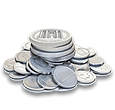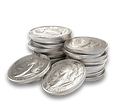Sovereign Gold Coin 101: A Complete Guide for Investors and Collectors
- GoldsilverJapan

- Jun 26
- 5 min read
Updated: Aug 13
When you think of iconic gold coins, few rival the prestige and global recognition of the sovereign gold coin. Whether you’ve encountered them as part of an estate, seen them offered by bullion dealers, or spotted them in numismatic auctions, the sovereign coin has a long, rich history that spans continents and empires.
But what exactly is a gold sovereign?Is it bullion, a collectible, or both?And is it right for your investment portfolio?
In this guide, we’ll break down everything you need to know about sovereign gold coins—from their royal origins to modern-day market performance. If you’re looking for a “Sovereign 101,” this is it.
What Is a Sovereign Gold Coin?
A sovereign gold coin is a British gold coin originally introduced in 1489 under King Henry VII, though the modern version dates back to 1817, following the Great Recoinage under King George III.
It was minted as legal tender and became the gold standard of the British Empire, circulating across many parts of the world including Australia, India, South Africa, and Canada.
Key Specs of the Modern Gold Sovereign:
Weight: 7.98 grams
Gold Content: 7.32 grams (0.2354 troy ounces)
Purity: 22-karat (91.67% gold, alloyed with copper for durability)
Diameter: 22.05 mm
Face Value: £1 (nominal)
Minted by: The Royal Mint and historic branches like Perth, Ottawa, Bombay, and Pretoria
A Brief History of the Gold Sovereign
The modern gold sovereign was reintroduced in 1817 following the Napoleonic Wars, as Britain sought to restore financial stability. The coin quickly became a symbol of monetary integrity, widely used in commerce and respected internationally.
During the Victorian and Edwardian eras, sovereigns were struck not only in London but also at overseas mints across the British Empire—each mint often leaving its own mark (e.g., "P" for Perth, "M" for Melbourne).
Notable Periods in Sovereign History:
1817–1837: Reign of George III and George IV—revival of the coin
1838–1901: Queen Victoria’s reign—“Young Head,” “Jubilee Head,” and “Old Head” types
1902–1910: King Edward VII
1911–1932: King George V (last regular circulating issues)
1957–present: Reintroduced for bullion under Queen Elizabeth II; continued with King Charles III
Today, gold sovereigns are still produced, mostly for investment and collectors, by the Royal Mint in the UK.
The Design: Classic & Royal
The sovereign is renowned for its timeless and regal design:
Obverse:
Features the reigning monarch at the time of minting (e.g., Victoria, Edward VII, George V, Elizabeth II, Charles III)
Each effigy reflects the monarch’s appearance and era
Recent sovereigns feature King Charles III (as of 2023+)
Reverse:
St. George slaying the dragon, a powerful image sculpted by Benedetto Pistrucci in 1817
An enduring symbol of valor and tradition
Some special editions have alternate reverse designs (e.g., for jubilees or anniversaries)
Sovereign Gold: Bullion or Numismatic?
This is where things get interesting.
A sovereign can be both a bullion coin and a collectible, depending on a few key factors:
👉 Sovereign as Bullion:
Modern sovereigns (post-1957) are generally considered bullion coins
They are traded close to spot value with modest premiums
Often used by investors in Europe due to favorable tax status (e.g., VAT and CGT exemptions in the UK)
👉 Sovereign as Numismatic:
Pre-1932 sovereigns, especially those from rare mints or in high grade, can command significant premiums
Coins from Bombay (India), Ottawa (Canada), or low-mintage years (like 1917 London) are highly collectible
Graded coins in MS63+ by NGC/PCGS can sell well above melt value
💡 In short:
If you buy sovereigns for gold exposure, stick to modern issues.
If you buy for collectible value or historic rarity, research mint marks and condition carefully.
Pros of Buying Sovereign Gold Coins
✅ 1. Global Recognition & Liquidity
Sovereigns are one of the most internationally recognized small gold coins, accepted by dealers and collectors worldwide.
✅ 2. Durable 22K Alloy
Their copper-alloyed gold (91.67%) makes them more scratch-resistant and durable than 24K pure gold coins like the Canadian Maple Leaf.
✅ 3. Excellent for Smaller Purchases
At 0.235 oz, sovereigns are ideal for investors who want to accumulate gold in smaller, more flexible denominations.
✅ 4. Historic Appeal
Unlike generic bullion, each sovereign comes with royal history, unique design, and often, a backstory of the minting location and monarch.
✅ 5. Often Tax-Advantaged (UK/EU)**
In certain jurisdictions (e.g., the UK), sovereigns are exempt from Capital Gains Tax (CGT)—a big advantage over bars or foreign bullion.🛑 (Note: Not applicable in Japan, but it adds to global demand and resale value.)
Cons or Challenges of Sovereign Gold
❌ 1. Premiums Vary by Country
In Japan and Asia, sovereigns are not as familiar as in the UK or Europe, and therefore may not always command the same premium when reselling.
In the UK, they’re often favored.
In Japan or the U.S., Krugerrands, Eagles, or Maple Leafs may be more liquid or in-demand.
❌ 2. Small Size, Small Weight
Because sovereigns contain less than 1/4 oz of gold, investors looking for pure bullion exposure may prefer full 1 oz coins (e.g., Maple Leaf or Britannia).
❌ 3. Complexity for New Buyers
With dozens of monarch types, mint marks, and design variations, sovereigns can be confusing. It’s best to do research or buy from trusted dealers.
❌ 4. Counterfeits Exist
As with all high-value coins, forgeries exist, especially with older or rare-date sovereigns. Always buy certified or from reputable sources.
Is a Sovereign Right for You?
A sovereign gold coin is ideal if:
You want a globally recognized gold coin under 1 oz
You value historic design and British heritage
You're building a diversified physical gold stack
You’re buying in a jurisdiction where sovereigns are well understood (UK, Europe)
A sovereign might not be ideal if:
You’re focused on lowest cost per gram of gold
You prefer high-purity (24K) gold coins
You're buying in a region where sovereigns are less familiar or in lower demand
Final Tips Before You Buy Sovereigns
✅ Stick with modern sovereigns if buying for gold stacking
✅ Look for older sovereigns (pre-1932) if interested in collecting or rare mintmarks
✅ Buy from dealers who offer authenticity guarantees or certified coins (NGC, PCGS)
✅ Consider the buy-back market in your country—some nations (like the UK or Australia) have strong resale demand for sovereigns
✅ Store them properly—sovereigns may be durable, but protection against oxidation and wear is still important
Where to Buy Sovereign Gold Coins
At GoldSilverJapan, we offer:
✅ Modern bullion sovereigns (new or lightly circulated)
✅ Graded collectible sovereigns (NGC/PCGS-certified)
✅ Historic sovereigns from Victoria, Edward VII, and George V
✅ Trusted sourcing and transparent pricing based on live gold spot
Whether you're buying for bullion exposure or adding a historic piece to your collection, we make it easy and secure.











Comments